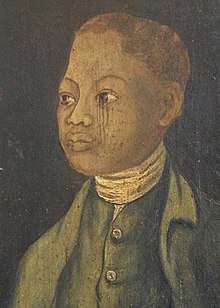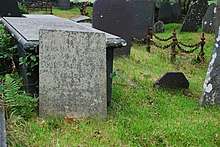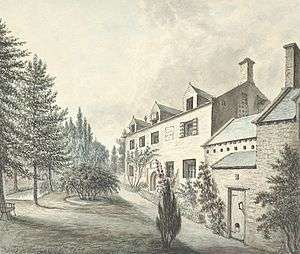John Ystumllyn
John Ystumllyn (died 1786), also colloquially known as Jac Du or Jack Black, was an 18th-century Welsh gardener and the first well-recorded black person of North Wales.
John Ystumllyn | |
|---|---|
 Portrait of John Ystumllyn, dated to 11 May 1754, depicting Ystumllyn as a teenager | |
| Died | 1786 |
| Burial place | St Cynhaearn's Church, Wales |
| Occupation | Gardener |
John was of uncertain origin, possibly a victim of the Atlantic slave trade, and from either West Africa or the West Indies. Early in his life, he was taken by the Wynn family to its Ystumllyn estate in Criccieth, where he was christened, and given the Welsh name John Ystumllyn. Here he was "domesticated", as he was taught English and Welsh by the locals. He learned horticulture and craftsmanship, at which he had some natural skill, in the estate garden. He worked as a gardener at the estate and eventually "grew into a handsome and vigorous young man", with his portrait painted at around this time. Doted upon by several local girls, he began a romance with the local maid Margaret Gruffydd.
As Margaret moved to different employments, Ystumllyn followed her, eventually running away from his job as gardener to marry in 1768. They had seven children, five of whom survived, with several of their descendants still living in the area as of 2019. They initially worked as land stewards, but Ystumllyn eventually re-entered into the employment of the Wynn family. In recognition of his service, Ellis Wynn gave Ystumllyn a large, ancient garden and cottage at Y Nhyra Isa. Ystumllyn died in 1786, with his wife dying in 1828, over forty years later.
Ystumllyn was well-liked in his time, and met with little racial prejudice, though he often encountered surprise and ignorance from locals over his unfamiliar appearance. Several years after his death, a small monument was constructed in his place of burial, St Cynhaearn's Church. Over a hundred years after Ystumllyn's death, the Welsh writer Robert Isaac Jones published an account of Ystumllyn's life, compiled from various local oral records. This work, while also criticised for its "forgetfulness" and "racial stereotyping", serves as "the most informative" extant source of Ystumllyn's life. According to Jones, John Ystumllyn was "a very honest man, with no malice, and was respected by the gentry and the common people alike".
Sources
Several Black Welsh individuals are recorded as living in Wales before Ystumllyn, mainly employed as servants and musicians to landowners and the aristocracy, following the vogue in Britain. Welsh historian David Morris has identified 29 black people in South Wales parish registers between 1687 and 1814, including a horn player of Erddig whose master had his portrait painted. Ystumllyn's biographer, Andrew Green, speculates that yet "more remain to be discovered" in North Wales, even if "their absolute numbers were small".[1] Despite this, Ystumllyn has been described as the first black person of North Wales "about whom we have detailed knowledge" by Green, writing for the Oxford Dictionary of National Biography.[2] Ystumllyn's life is known from three sources, "all of them remarkable", according to Green.[1]
The earliest is a small oil painting on wood, produced by an unknown artisan artist, with a date and identification at the foot: "John Ystymllyn, 11 May 1754". This portrait shows his features as a young man, wearing a green jacket, green buttoned waistcoat and white neckband, garments typical of his working position.[1][3]

The next is his simple sandstone memorial in the graveyard of St Cynhaearn's Church, Ynyscynhaearn, a former parish church now under the administration of the Friends of Friendless Churches. Here, Ystumllyn was possibly baptised, and was certainly buried in 1786. The memorial was erected posthumously. In 1999, it was made a Grade II listed building "as of special interest in commemorating a slave in service in Wales in the later years of the C18 [18th-century], who must have been well enough thought of that he was provided with a handsome memorial".[4] The memorial's inscription gives his age at the time of death as forty-six, but incorrectly gives his date of death as 1791. It bears a bleak, biographical englyn, composed by the Penrhyndeudraeth musician and poet Dafydd Siôn Siâms (1743–1831):[1][2][3][5]
|
Yn India gynna'm ganwyd a nghamrau |
Born in India, to Wales I came |
The final of these sources is a short Welsh-language pamphlet, John Ystumllyn neu 'Jack Black' (1888), by the Tremadog writer, Robert Isaac Jones (1813–1905), published under his bardic name, Alltud Eifion. Writing 102 years after Ystumllyn's death, Jones collated the various oral traditions of John that had passed down through his family, largely from his grandfather who had been Ystumllyn's doctor near the end of the gardener's life.[1][2] This publication was subsequently adapted into Jones' Y Gestiana (1892), and translated into English by the canon, Tom Morris.[6] Green has acknowledged the inadequacies of Jones' work, often "prone to variation, embroidery and forgetfulness", but it remains, in his view, "the most informative" and "frank" source for Ystumllyn's life.[1] The work has received more harsh criticism from the North Wales newspaper, The Daily Post, as "peppered with racial stereotyping" in its biography of Ystumllyn, citing it in an editorial as an example of the early racial prejudice against black integration in Wales.[7]
Biography
Robert Isaac Jones begins his account of Ystumllyn's life, admitting his uncertain origins, and tracing three narratives of his arrival in Wales.
%2C_Dictionary_of_Welsh_Biography%2C_cropped.jpg)
The first he sources to his mother, claiming that a member of the Wynn family of Ystumllyn, possibly Ellis Wynn, "who had a Yacht, caught the boy in a wood in Africa and brought him home to Ystumllyn", where "they judged him to be about eight years old, and they took him to the Church in Criccieth, or Ynys[cynhaearn], to be christened, and called him John Ystumllyn".[8] Ystumllyn's true birth name is unknown.[2] Another narrative, derived from Ystumllyn's descendants, "stated that a number of black boys arrived in London, and that Ellis Wynne of Ystumllyn's sister, who lived in London, sent him as a gift to her brother".[9] Green notes that Wynn's sister, Mary, married a William Hollier, possibly the same Hollier who was the first secretary of the African Company of Merchants, integral in the Gold Coast's slave trade.[2] The third account, from John himself, asserted that he was captured by white men while "on the banks of a stream amid woodland attempting to catch a moorhen" and taken to their ship, to the "frightful howls" of his mother.[9] Green is more skeptical of these stories, stating that, while it was "not inconceivable that Wynne was directly implicated in the slave trade", "it's much likelier that John came from a slave family in the West Indies", citing the reference to an Indian origin on his gravestone.[1]
John's arrival in Ystumllyn was marked by his knowledge of "no language other than sounds similar to the howling of a dog", in Jones' words;[9] this was most likely a West African language, unfamiliar to the Welsh locals.[1] Jones speaks of the locals "domesticating" Ystumllyn, meeting with "considerable difficulty for a long time", first keeping him indoors, and – with the help of local women – teaching him to be fluent and literate in both Welsh and English. Ystumllyn was then put in the garden, where he showed a gift for crafts and horticulture, and developed a fondness for floristry.[2][9] According to Tom Morris, "it was remarked that this very black skin had very green fingers".[10] He found employment on the Ystumllyn estate as a gardener, for what Morris reported was very low pay, his upkeep being "less costly than that of a racehorse".[10] On 11 May 1754, he sat for his oil painting, at which time Jones estimated he was aged around sixteen.[2][9]
Here, Ystumllyn "grew into a handsome and vigorous young man", according to Jones, and "there was much rivalry between [the young ladies of the area] in order to get John as a suitor." One unmarried maid from Hendre Mur, Trawsfynydd, Margaret Gruffydd, was tasked with bringing John "some bread, cheese and ale from the Plas". She was initially terrified of John and ran away upon the sight of him, but over time she grew more comfortable around him, and a romance developed. When Margaret moved to her relatives' nearby mansion, Ynysgain Bach, Criccieth, for domestic work available there, Ystumllyn continued his courtship of her. Jones recounts the shock of the house's master at Ystumllyn, stumbling across Ystumllyn in the kitchen, assured that he must be "the Black Devil" because of his dark skin. Margaret moved once again to Dolgellau, where Ystumllyn followed her. To pursue her further, Ystumllyn ran away from his job at Ystumllyn estate, with Margaret following him the next morning. The two were married on 9 April 1768, in Dolgellau, with Griffith Williams, son of the local vicar, as Ystumllyn's best man.[1][2][10][11]

After their marriage, John and Margaret lived in Ynysgain Fawr, west of Criccieth, where they were employed as land stewards.[12] They had seven children, with the first two dying while young, and the other five living to adulthood. As of 2019, several descendants of the Ystumllyn family still live in the area.[2] John later worked at the home of Maesyneuadd, near Talsarnau, another estate of the Wynn family. Near the end of his life, in "recognition for his service", Ellis Wynn gave Ystumllyn the house of "Y Nhyra Isa" or "Nanhyran", a small thatched cottage surrounded by a large, ancient garden.[1][2][13]
Ystumllyn died of unknown causes and was buried in St Cynhaearn's Church on 2 July 1786.[2] Jones recounts that, on his deathbed, Ystumllyn told a neighbour "his main regret was that he played the crwth on Sundays at Ystumllyn and Masyneuoedd".[14] Margaret died in 1828, at Y Nhyra Isa at the age of eighty-one, outliving John by over forty years. She was apparently in good health up to this point, being able to "see to sew and knit up until a few months before her death", and "was a quiet and cheerful old lady".[5] The couple's only son, Richard Jones (d. 1862), is covered in detail in Jones' pamphlet; he lived until ninety-two, served under Spencer Bulkeley Wynn, 3rd Baron Newborough for fifty-eight years as his huntsman, and received a pension from the Baron in old age.[1][2][12]
Character and reputation
Jones concludes his account of Ystumllyn with several anecdotes of his character.[1] He was, by all accounts, a "very honest man, with no malice, and was respected by the gentry and the common people alike".[14] "He was considered by the old folk as a very moral man. [...] The colour of his skin drew a lot of attention in those days, and his position with the most important gentry of the area, drew more of the attention of the common people, than anyone else."[14]
The locals held many "strange ideas" about Ystumllyn because of his black skin, which Jones duly documented; two maids had wondered out loud if "that man's blood is red like the blood of white men", meeting with a sharp retort from Ystumllyn: "Silly fool, you kill a black hen and a white hen, and you'll see the blood of both is red".[15] The local children apparently feared him, "because they had not seen a black man before".[14] "Although the presence of a black man in Gwynedd inevitably aroused surprise and even shock", according to Green, "there's no suggestion that anyone held racist attitudes towards John".[1] Green quotes one of Jones' anecdotes at length that, he claims, "reveals much about at least one person's 'blindness' to ethnicity:"[1]
The late Ellis Owen, Cefnmeusydd, use to relate an interesting story about Margaret Jones, y Nhyra, at Penmorfa Fair when Richard her son (Richard Jones, Huntsman, Glynllifon, later) was around 2 years old, and she took him on her arm on the afternoon of the Mayday Fair, as was the practice in those days, and John Ystumllyn went to the Fair in the evening. The child saw his father a distance away and shouted "Dada, Dada"; then his mother said to her friends "have you seen such a smart child as this one, recognising his father among so many people," without considering that his father was black as soot in the midst of white people; as the old adage says – "The crow sees its chick as white" (Gwyn y gwêl y fran ei chyw).[16]
Legacy
Writing in 1962, Tom Morris described the story of Ystumllyn and Margaret surviving in Wales as "something of a legend; the memory of their courage – which braved the barriers of colour and class in 18th-century Wales – still lingers on".[10] In 2018, commemorating Black History Month in the United Kingdom, John Ystumllyn was included on a list of 100 "Brilliant, Black and Welsh" people, featured on WalesOnline.[17] In October 2019, again to celebrate Black History Month, the Oxford Dictionary of National Biography introduced 23 new biographies of black British people, curated by historians Miranda Kaufmann and Anders Ingram. This selection included Ystumllyn, who Ingram cited as "the most emblematic of the theme of this release", a man "whose settled life existence in rural Wales reminds us of the persity of the historical experience of black people in Britain".[18]
See also
- Cesar Picton (1755–1836), a later black Briton, with a similar history involving a Welsh landowning family, but based near London.
References
- Green 2017.
- Green 2019.
- Friends of Friendless Churches.
- British Listed Buildings.
- Jones 1888, p. 7.
- Edwards & Walvin 1983, p. 218.
- Daily Post 2005.
- Jones 1888, pp. 4–5.
- Jones 1888, p. 5.
- Morris 1962.
- Jones 1888, pp. 5–6.
- Jones 1888, p. 6.
- Jones 1888, pp. 6–7.
- Jones 1888, p. 8.
- Jones 1888, pp. 7–8.
- Jones 1888, p. 9.
- Wightwick 2018.
- Ingram 2019.
Sources
- "Gravestone of John Ystymllyn: A Grade II Listed Building in Dolbenmaen, Gwynedd". British Listed Buildings. Retrieved 28 October 2019.
- "Are we less racist than the rest of Britain?". Daily Post. 24 March 2005. Retrieved 11 October 2019.
- Edwards, Paul; Walvin, James (1983). Black Personalities in the Era of the Slave Trade. London: Macmillan Press. doi:10.1007/978-1-349-04043-8. ISBN 978-1-349-04045-2.CS1 maint: ref=harv (link)
- "John Ystumllyn: From Africa to Ynyscynhaiarn". Friends of Friendless Churches. Retrieved 11 October 2019.
- Green, Andrew (27 August 2017). "John Ystumllyn: an African in 18th century Eifionydd". Gwalter. Retrieved 11 October 2019.CS1 maint: ref=harv (link)
- Green, Andrew (10 October 2019). "Ystumllyn, John (d. 1786), gardener". Oxford Dictionary of National Biography (online ed.). Oxford University Press.CS1 maint: ref=harv (link) (Subscription or UK public library membership required.)
- Eifion, Alltud [Jones, Robert Isaac] (1971) [1888]. John Ystumllyn or 'Jack Black': the history of his life and traditions about him since his capture in the wilds of Africa until his death; his descendants, etc. etc., together with a picture of him in the year 1754 (PDF). Translated by Morris, Tom. Tremadoc. Retrieved 11 October 2019.CS1 maint: multiple names: authors list (link)
- Ingram, Anders (17 October 2019). "Early black British history and the Oxford DNB". Oxford Dictionary of National Biography. Retrieved 17 October 2019.CS1 maint: ref=harv (link)
- Morris, Tom (6 September 1962). "An Elopement in 18th-Century Wales: Jack Black of Ystumllyn". Country Life. p. 518.CS1 maint: ref=harv (link)
- Wightwick, Abbie (28 September 2018). "Brilliant, Black and Welsh: A celebration of 100 African Caribbean and African Welsh people". WalesOnline. Retrieved 11 October 2019.CS1 maint: ref=harv (link)